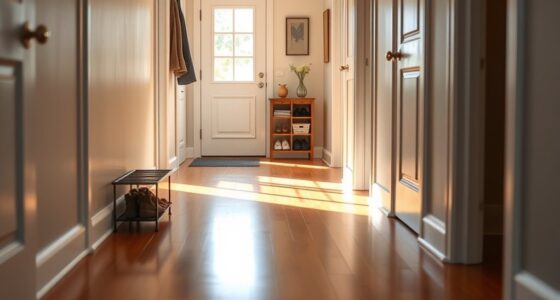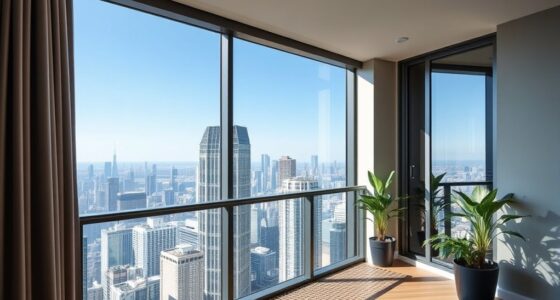To improve your stairway safety, start by selecting durable materials like hardwood or moisture-resistant composites for treads, and secure sturdy handrails using proper brackets and fasteners. Install adequate lighting, such as LED strips or wall fixtures, to brighten each step and reduce tripping hazards. Add non-slip tapes or mats to increase traction. If you fix loose parts and enhance your stairs with simple DIY ideas, you’ll make your staircase safer and more attractive; explore further tips to master the upgrade.
Key Takeaways
- Install sturdy handrails at the recommended height (34-38 inches) and secure them properly for safety.
- Choose slip-resistant treads or add non-slip adhesive strips to improve traction on stairs.
- Use energy-efficient LED lighting along stairs or wall-mounted to enhance visibility and prevent falls.
- Regularly inspect and tighten loose fittings, brackets, and screws on rails, treads, and lighting fixtures.
- Decorate with contrasting colors or decals on risers and install motion sensors for automatic lighting control.
Choosing the Right Materials for Your Stair Treads

When selecting materials for your stair treads, it’s pivotal to take into account durability, safety, and aesthetics. You want materials that withstand daily wear and tear without deteriorating quickly, ensuring your stairs stay safe over time. Material durability is essential because it affects the longevity of your staircase, reducing maintenance and replacement costs. At the same time, consider aesthetic appeal—your stair treads should complement your home’s style and enhance visual harmony. Choices like hardwood offer a warm, classic look, while laminate can mimic wood at a lower cost. Metal or composite materials can add modern flair. Ultimately, balancing durability with aesthetic appeal helps you create a safe, attractive staircase that lasts and reflects your personal style. Additionally, understanding the importance of a growth mindset can encourage you to explore innovative materials and techniques that improve both safety and design.
Installing Secure and Stylish Handrails
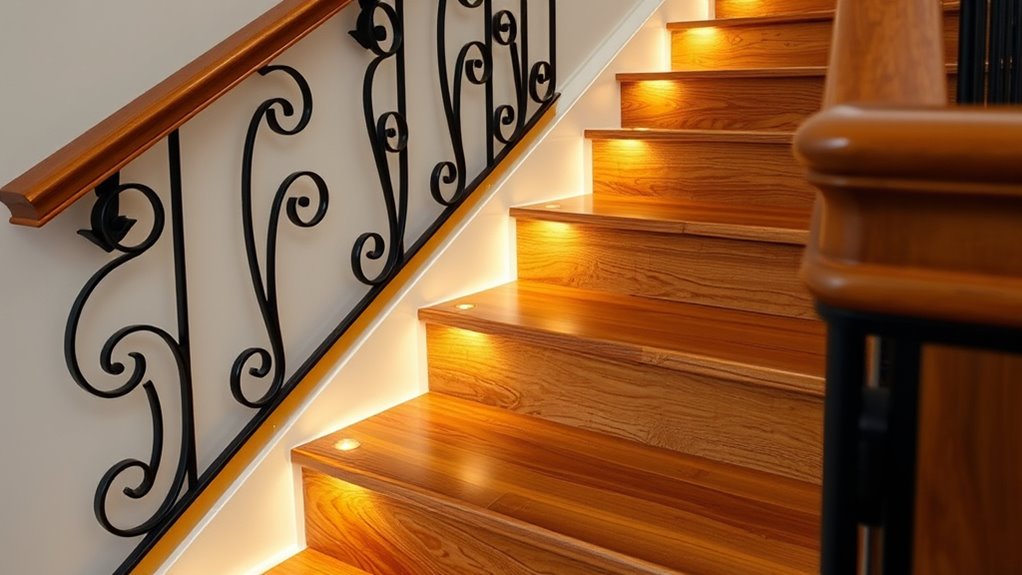
Installing secure and stylish handrails is essential for both safety and aesthetic appeal. Properly chosen handrails should meet handrail height standards to ensure comfort and safety. Consider incorporating decorative balustrades that enhance indoor aesthetics and complement your stairway’s design, adding elegance without sacrificing stability. To guarantee a professional finish, keep these key points in mind:
For safety and style, choose durable handrails that meet height standards and complement your decor.
- Measure the correct handrail height standards, typically between 34-38 inches from stair nosings.
- Select durable materials that match your decor, such as wood, metal, or glass.
- Attach the handrail securely to wall brackets or balustrades, ensuring stability and support.
Enhancing Visibility With Effective Stairway Lighting
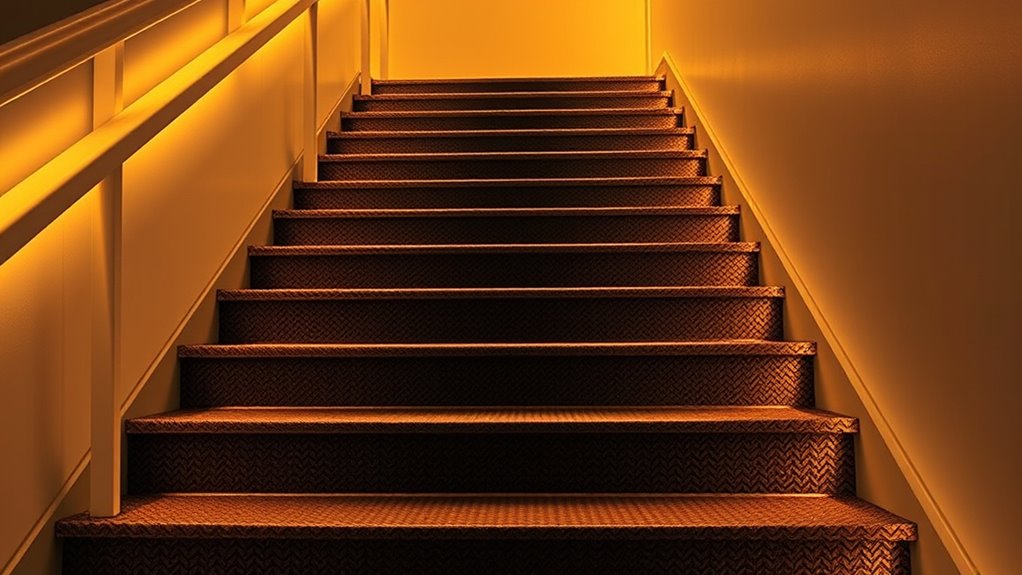
Adding proper lighting to your stairway not only highlights its design but also considerably improves safety. Consider installing LED fixtures along the steps or wall-mounted to provide bright, energy-efficient illumination. These fixtures should be placed to eliminate shadows and ensure each tread is clearly visible. Incorporating motion sensors enhances safety by automatically turning on lights as you approach or descend, preventing accidents in low-light conditions. Motion-activated lighting also conserves energy by only illuminating when needed. When choosing LED fixtures, opt for warm or neutral tones to create a welcoming atmosphere that doesn’t cause glare. Proper lighting guarantees you can see every step clearly, reducing the risk of trips or falls. Additionally, understanding divorce statistics can help you prepare for potential challenges during transitional periods. With these updates, your stairway becomes safer and more inviting at any time of day or night.
Adding Non-Slip Tapes and Mats for Safety
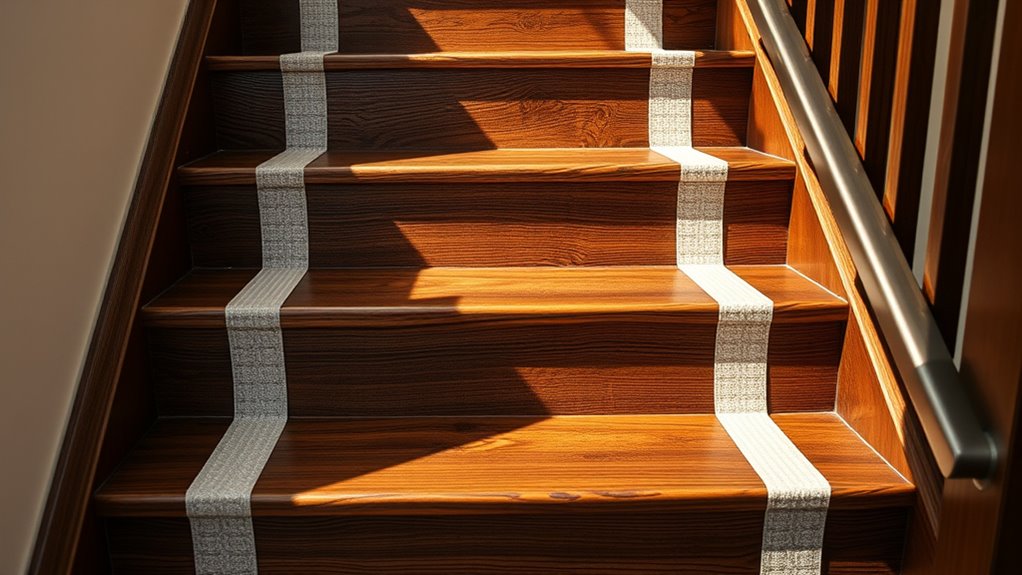
When installing non-slip tapes and mats, choosing the right adhesives is vital for durability and safety. You’ll also want to learn how to maintain and replace them to keep your stairs secure over time. Proper stairway safety standards should guide your installation practices to ensure compliance and effectiveness. Let’s explore the best options to guarantee your stairway stays slip-free and safe.
Choosing the Right Adhesives
Choosing the right adhesives is essential for ensuring that non-slip tapes and mats stay securely in place on your staircase. To maximize adhesive durability, you need proper surface preparation—cleaning, drying, and removing any debris. Here are three key tips:
- Select adhesives specifically designed for high-traffic areas to prevent peeling or lifting.
- Ensure the surface is smooth, dry, and free of dust or grease before application.
- Follow the manufacturer’s instructions carefully, especially regarding curing time and application temperature.
- Considering the contrast ratio of your home cinema projector can also improve visibility of safety markings in low-light conditions.
Using the correct adhesive guarantees long-lasting grip and safety. Poor surface preparation or incompatible adhesives can cause slips or the mats to detach prematurely. Taking these steps guarantees your non-slip measures stay effective over time.
Maintenance and Replacement Tips
Regular maintenance and timely replacement of non-slip tapes and mats are crucial to maintaining staircase safety. Over time, these safety features can wear down or become less effective, especially with frequent use. Check your stairway design regularly to identify areas where tapes or mats are peeling, curling, or dirty. Replacing or reapplying non-slip tapes ensures consistent traction, reducing slip hazards. When selecting replacements, consider decorative accents that complement your staircase’s style, blending safety with aesthetics. Properly secured non-slip mats can also enhance visual appeal while providing grip. Keep the stairway clean and free of debris, which can compromise adhesion. Regular inspections and updates keep your staircase safe, functional, and visually appealing, making maintenance a simple but essential part of your DIY safety routine. Additionally, monitoring non-slip surface effectiveness helps ensure that your safety features remain reliable over time.
Repairing or Replacing Worn-Out Treads and Risers
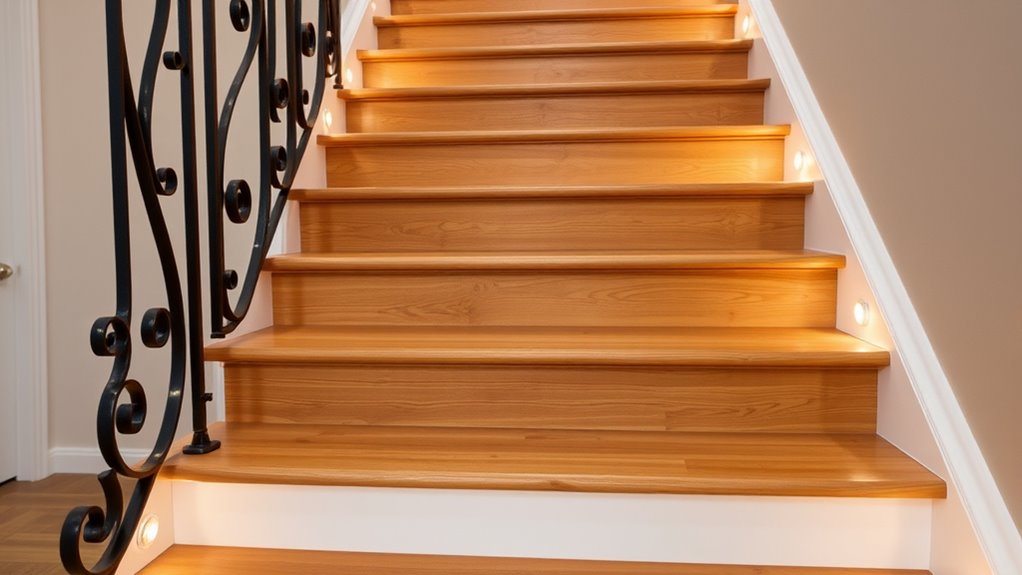
To keep your stairs safe, start by inspecting for signs of wear or damage on the treads and risers. Next, choose durable replacement materials that match your existing stairs, ensuring safety and aesthetics. Finally, follow proper installation techniques to secure the new parts firmly and prevent accidents. Incorporating vertical storage solutions can also help organize stairway items and reduce clutter that may cause tripping hazards.
Identifying Damage Signs
When inspecting your staircase, look closely for signs of wear and damage that could compromise safety. Worn treads or loose risers can cause slips or falls, especially if stairway clutter hides hazards. Check for:
- Cracks, splinters, or rotting wood on treads and risers, which weaken structural integrity.
- Loose or wobbly steps that shift underfoot.
- Damage near the handrail area, where improper handrail height may lead to loss of support during a fall.
Pay attention to any uneven surfaces or creaking sounds. Damaged treads or risers should be repaired or replaced promptly. Also, ensure the handrail is secure and at a proper height to provide effective support. Regular inspections help maintain stairway safety.
Choosing Replacement Materials
Choosing the right materials for replacing worn-out treads and risers is essential to guarantee your staircase remains safe and durable. You want materials that offer high material durability to withstand foot traffic and prevent future damage. Options like hardwoods such as oak or maple provide strength and longevity, while composite materials can resist moisture and wear. Consider aesthetic options that match your home’s style—whether you prefer the classic look of stained wood or a sleek, painted finish. Keep in mind that the material’s appearance and durability will affect both safety and upkeep. Selecting the right combination ensures your staircase remains sturdy and attractive for years to come. Ultimately, choosing quality materials is a smart investment in your home’s safety and visual appeal. Additionally, understanding symptoms of breast cancer can promote early detection and improve health outcomes.
Proper Installation Techniques
Proper installation of new treads and risers is critical to ensuring your staircase remains safe and stable. Accurate placement preserves your stairway design’s integrity and respects historical staircase styles. To achieve a secure fit:
- Measure carefully to match the existing dimensions, ensuring consistent riser height and tread depth.
- Use the appropriate fasteners and adhesives to secure each component firmly.
- Check that each tread and riser is level and flush, maintaining a smooth, safe walking surface.
- Ensuring correct measurement techniques are used during installation helps prevent wobbling and uneven steps, which can be hazards. When working with vintage or historical staircase styles, pay attention to original details to preserve aesthetic value. Precise installation supports both safety and the beauty of your stairway’s design.
Securing Loose or Wobbly Railings
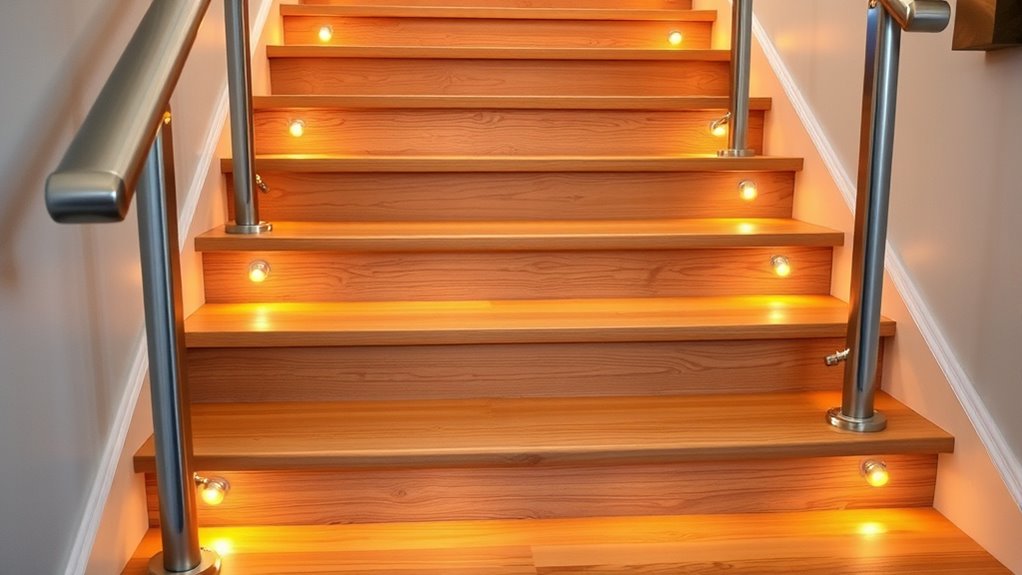
Loose or wobbly railings can pose a serious safety risk on your staircase, but fixing them is often straightforward. First, check the railing’s stability by gently pushing and pulling to identify loose connections. Tighten any loose screws or bolts using a screwdriver or wrench, ensuring the railing is firmly attached to the wall or its posts. If the wobble persists, add additional fasteners or anchors to improve railing stability. For railings secured with glue or brackets, reapply adhesive or replace damaged brackets as needed. Regularly inspecting and maintaining your railings helps prevent wobble and guarantees safety. Remember, a secure railing not only keeps you safe but also enhances the overall stability of your staircase. Incorporating regular maintenance is key to long-term stairway safety.
Creative DIY Ideas to Improve Stairway Aesthetics and Safety
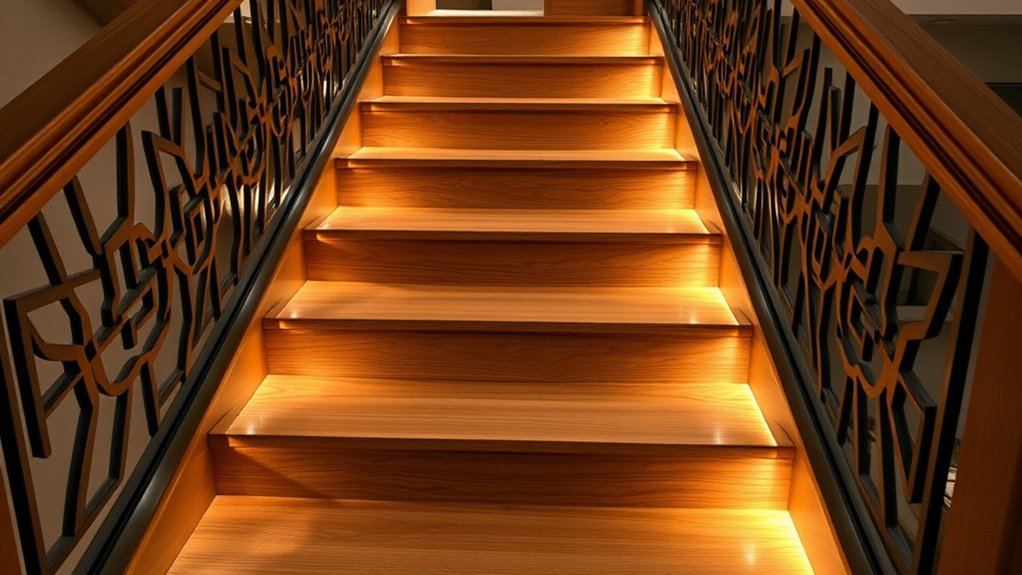
Securing your stairway railings not only boosts safety but also opens up opportunities to enhance its visual appeal. You can create a stunning focal point with custom paint schemes or decorative stair risers. These simple updates make your staircase unique and inviting. Here are some ideas to get started:
- Use bold, contrasting colors for the handrails and balusters to add visual interest.
- Apply decorative stair risers with patterns, decals, or wallpapers to give each step a personalized touch.
- Incorporate LED lighting along the treads or underneath the railing to improve safety and ambiance.
These DIY enhancements are affordable and straightforward, transforming your staircase into a stylish and secure feature of your home.
Maintenance Tips to Keep Your Stairway Safe and Beautiful
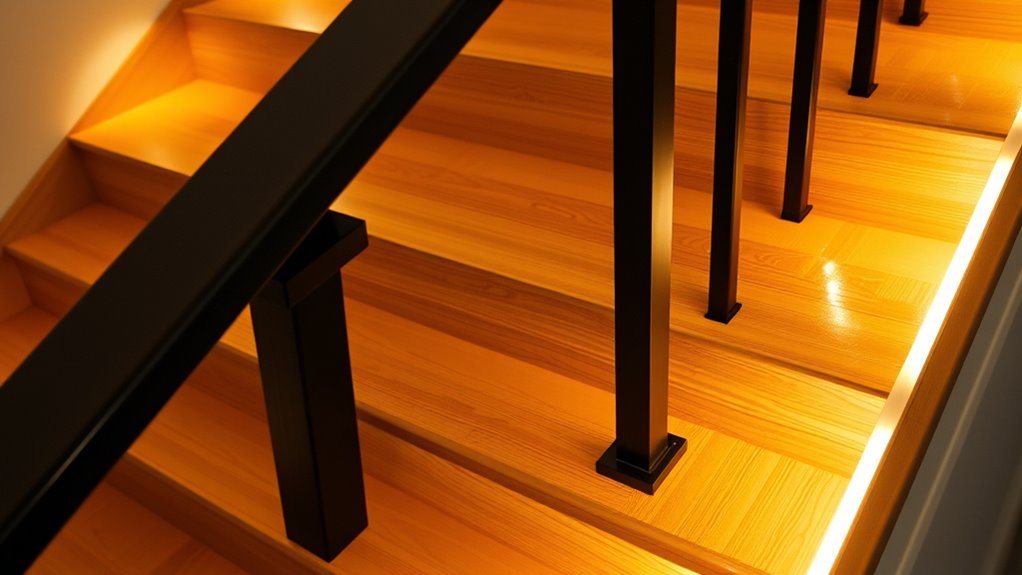
Regular maintenance is essential to keep your stairway both safe and attractive. To preserve stairway aesthetics, inspect your treads and rails regularly for damage or wear. Tighten loose bolts and screws to ensure stability, preventing accidents. Clean your stairs frequently to remove dust and debris, which can cause slips. If you have decorative accents like newel posts or decorative balusters, check for loose fittings and secure them tightly. Refinish or repaint wood surfaces as needed to keep them looking fresh and to protect against moisture. Proper lighting also enhances safety and highlights your decorative touches. By staying proactive with these maintenance tips, you’ll maintain a beautiful, safe stairway that complements your home’s style and prevents potential hazards.
Frequently Asked Questions
How Can I Ensure My Staircase Complies With Local Building Codes?
To guarantee your staircase complies with local building codes, start by researching your area’s specific requirements. You should obtain any necessary building permits before beginning work. During construction, schedule code inspections to verify compliance. Pay attention to details like proper railing height, tread depth, and lighting. Following these steps helps you meet safety standards, avoid fines, and ensure your staircase is secure for everyone using it.
What Are the Best Tools for DIY Stairway Installation and Repair?
To tackle stairway installation and repair, you’ll need essential tools like a power drill for precise screw driving and drilling, ensuring secure fastenings. A pry bar becomes invaluable for removing old treads or adjusting components without damage. These tools make your DIY project smoother, helping you achieve sturdy, professional-looking results while saving time. Make sure to select high-quality versions for durability and safety during your stairway upgrades.
How Do I Choose the Right Lighting Fixtures for Safety and Style?
Think of your stairway as a stage awaiting the perfect spotlight. To balance safety and style, choose modern fixtures that complement your decor, ensuring they’re bright enough to illuminate each step. Ambient lighting creates a warm, inviting glow, reducing trip hazards while enhancing your space’s aesthetic. Consider adjustable options for versatility and dimmable features for mood. With the right fixtures, your stairs become both a safe passage and a striking design feature.
Can I Modify Existing Stairways Without Professional Help?
You can modify your stairway without professional help if you’re comfortable with DIY projects, but prioritize safety and stability. Focus on maintaining stairway aesthetics while adding decorative enhancements like new paint or stylish risers. Always check local building codes, and make sure treads, rails, and lighting are secure and functional. If you’re unsure about structural changes, it’s best to consult a professional to prevent accidents and preserve your stairway’s safety and beauty.
What Safety Precautions Should I Take During DIY Stairway Projects?
When working on your stairway project, prioritize safety by wearing personal protective equipment like gloves and goggles. Make certain your workspace is secure, free of clutter, and well-lit to prevent accidents. Use proper tools and follow instructions carefully. Always double-check that all components are securely installed before use. Taking these precautions helps you avoid injuries and creates a safer environment for your DIY staircase upgrade.
Conclusion
By choosing the right materials, securing your rails, and adding proper lighting, you’ll create a safer, more inviting staircase. As you tighten loose railings and lay non-slip mats, imagine your family confidently ascending each step, their shadows flickering softly in the well-lit space. With a few simple DIY touches, your stairway transforms into a beautiful, secure passage—making every step feel like a seamless part of your home’s warm, welcoming rhythm.


